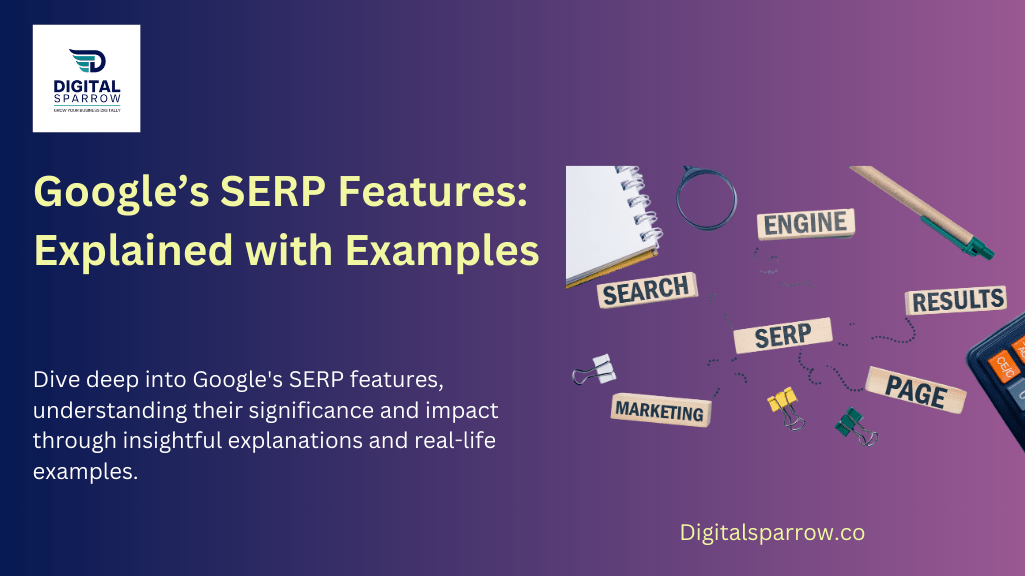Understanding how search engines deliver content to users in the always changing world of digital marketing is crucial for a successful online presence. Google, which is the most widely used search engine, uses a variety of Google SERP Elements to improve the user experience and deliver quick results. In this article, we will examine each of Google’s SERP elements and provide illustrated examples to show how important they are to contemporary SEO tactics.
Featured Snippets in Google SERP: Enhancing Search Experience
Featured snippets are prominent search results that provide direct answers to users’ queries. Displayed at the top of the search results, these snippets aim to offer immediate information without requiring users to click through to a website. Featured snippets can take various forms, including paragraphs, lists, and tables, depending on the nature of the query.
These snippets take and display text from high-ranking pages, providing brief and relevant responses to visitors’ concerns. They not only improve the search experience by providing quick solutions, but they also present website owners with an opportunity to acquire increased visibility and trust.
To optimise for featured snippets, focus on organising your content to address popular questions succinctly. Use headings, lists, and clear formatting to make it easier for Google to extract key information. Keep in mind that, while featured snippets might increase your organic visibility, they may also lead to lower click-through rates for specific queries because people can obtain the answers they need directly on the search results page.
Knowledge Graph in Google SERP: Unveiling Connected Information
The Knowledge Graph is Google’s ingenious feature that delivers comprehensive and contextually connected information directly within search results. It enhances the user experience by presenting essential facts and details about people, places, and things related to the search query. This feature showcases a panel on the right side of the search results page, offering a snapshot of the entity’s background, attributes, and associations.
The Knowledge Graph offers consumers a brief overview of information from several reliable sources, avoiding the need to go through multiple websites for fundamental information. Whether it’s knowledge on historical figures, landmarks, or even concepts, the Knowledge Graph’s semantic understanding bridges the gap between diverse pieces of information, providing users with a more holistic understanding of their searches.
Optimising for the Knowledge Graph for businesses and content creators entails maintaining correct and structured information on platforms such as Wikipedia and schema.org. This can result in improved brand visibility and authority, particularly for companies that people regularly search for.
2 Powerful Hacks to Drive High-Quality Traffic
Image Packs in Google SERPs: Evolving Visual Exploration
Image Packs, a new element of Google’s SERP, provide aesthetic appeal to search results by displaying a curated selection of photos connected to the user’s query. Image Packs, which are designed to cater to visitors wanting visual information, provide a dynamic and engaging method to explore themes such as trip locations, fashion trends, and DIY projects.
Users can quickly analyse and select material that connects with their goal with Image Packs, improving their search experience. This feature also provides opportunities for businesses and content developers to visually showcase their products and services. Optimising photos for search engines and integrating important metadata become critical in securing a spot within Image Packs, thereby increasing brand visibility and driving organic traffic.
As Google’s algorithms continue to refine the user experience, Image Packs are poised to become more immersive, potentially offering image carousels and interactive elements. Businesses that recognise and adapt to this visual shift will likely gain a competitive edge in capturing user attention and engagement.
Video Carousels: Google’s Search Engine Results Page (SERP) of the future may prominently incorporate Video Carousels, which show users a dynamic array of video content connected to their search queries. This immersive format provides for short previews and quick access to a wide range of videos, increasing user engagement and adapting to the visual aspect of online content consumption. Video Carousels have the potential to change the way people discover information and entertainment by creating a more engaging and aesthetically appealing search experience. As online video continues to grow in popularity, incorporating Video Carousels into SERPs could be Google’s forward-thinking plan to suit changing user tastes while maintaining its position as a search innovation leader.
Local Packs: In the future, Local Packs are anticipated to play a significant role in presenting users with extremely relevant and localised information on Google’s Search Engine Results Page (SERP). These packs will probably develop to provide even more specific insights as real-time information such as store foot traffic, current inventory status, and updated business hours is added. The Local Packs could be customised for each user’s tastes and actions with further personalisation. Users might be able to digitally explore nearby companies through integration with augmented reality (AR). Future Local Packs may offer a dynamic fusion of interactive, visual, and textual material to dramatically improve the user’s search experience as Google continues to improve its algorithm.
finding-the-right-funding-for-your-startup
People Also Ask (PAA): In the future environment of Google’s Search Engine Results Page (SERP), the People Also Ask (PAA) feature is poised to experience transformational changes. As search engines get more sophisticated, PAA will most likely present users with a dynamic and contextually refined set of questions that are closely aligned with their search intent and preferences. The replies could evolve to include multimedia features like films, photos, and interactive graphs, offering a more immersive and instructive experience. Furthermore, as AI and natural language processing develop, PAA may engage in real-time, natural language discussions, providing rapid and thorough responses. This could make it easier to go further into issues of interest.
Furthermore, PAA’s future iterations might incorporate predictive analytics to anticipate users’ follow-up queries, proactively addressing their information needs. With personalisation at the forefront, the feature could tailor suggestions based on past behaviour and demographics. These enhancements in PAA would revolutionise how users interact with search results, enabling more efficient exploration, a broader understanding, and ultimately a more satisfying and enlightening search journey.
Site Links: In the future of Google’s Search Engine Results Page (SERP), Site Links are poised to undergo significant refinement. These enhanced links could provide users with more direct access to specific areas or pages on a website, anticipating their intent and preferences. With advances in machine learning and user behaviour analysis, these links may dynamically modify based on real-time interactions, enabling more relevant and context-aware navigation. In addition, “Site Links” could include visual previews or interactive snippets that provide a preview of the connected page’s content. As search engines become more intuitive, these enhancements may improve the user experience by minimising click-throughs and expediting access to desired information. This evolution of “Site Links” is consistent with Google’s aim to optimise the user journey, making SERPs more efficient, informative, and user-friendly.
Reviews and Ratings: In the future of Google’s Search Engine Results Page (SERP), “Reviews and Ratings” are anticipated to play an even more central role in aiding user decisions. These elements could become more comprehensive and interactive, offering deeper insights through sentiment analysis and sentiment trends over time. Verified reviews might hold greater prominence, enhancing credibility and trust. The integration of AI could enable a more personalised display of reviews based on individual preferences. Visual representations, such as infographic summaries, may provide a rapid overview of aggregated scores. Furthermore, predictive analysis could provide projected experiences based on prior data. As user-generated material continues to affect attitudes, Google’s future SERP may provide consumers with a greater array of review information, allowing them to make more educated decisions more efficiently.
Twitter Feeds: In the prospective landscape of Google’s Search Engine Results Page (SERP), “Twitter Feeds” could evolve into a more prominent and dynamic feature. Real-time tweets from individuals, businesses, and news sources might be seamlessly integrated, offering up-to-the-minute insights on trending topics, events, and breaking news. The display could include multimedia features like photographs and videos directly within the SERP, allowing consumers to interact with material without leaving the search page. Improved filtering tools could allow consumers to tailor their feeds depending on their preferences. Additionally, AI-driven sentiment analysis could add context by summarising the overall tone of discussions about a specific issue. This progression would cater to users looking for the most recent and relevant updates, further blurring the distinctions between social media and traditional search results.
Rich Results for Recipes and Events: In the future of Google’s Search Engine Results Page (SERP), “Rich Results” for recipes and events are poised to become highly immersive and informative. For recipes, these rich results might include not only detailed ingredient lists and cooking instructions but also interactive elements like step-by-step visual guides and video tutorials. Users could custozise serving sizes and get instant nutritional information. Similarly, event-related results could offer dynamic previews, showcasing event details, ticket availability, and interactive seating plans. Real-time updates might reflect changing event statuses.
Furthermore, these rich results may allow users to perform activities like saving recipes, creating reminders for occasions, or even purchasing event tickets straight from the SERP. Voice commands could enable hands-free engagement with improved mobile optimization. AI-powered customization may adjust recommendations based on previous preferences. As a result, these rich results would provide users with greater ease, interactivity, and engagement, altering how users access and interact with recipe and event information on Google SERPs.
As Google continues to refine its search results page, understanding and leveraging these SERP features can significantly impact your online visibility and user engagement. By tailoring your content to these features and providing valuable information, you can enhance your website’s chances of standing out in the crowded digital landscape. Keep in mind that Google’s algorithms are constantly evolving, so staying updated with the latest trends in SERP features is crucial for staying ahead in the digital marketing game.


I don’t think the title of your article matches the content lol. Just kidding, mainly because I had some doubts after reading the article.
Your article helped me a lot, is there any more related content? Thanks! https://www.binance.com/ES_la/register?ref=T7KCZASX
Thanks for sharing. I read many of your blog posts, cool, your blog is very good.